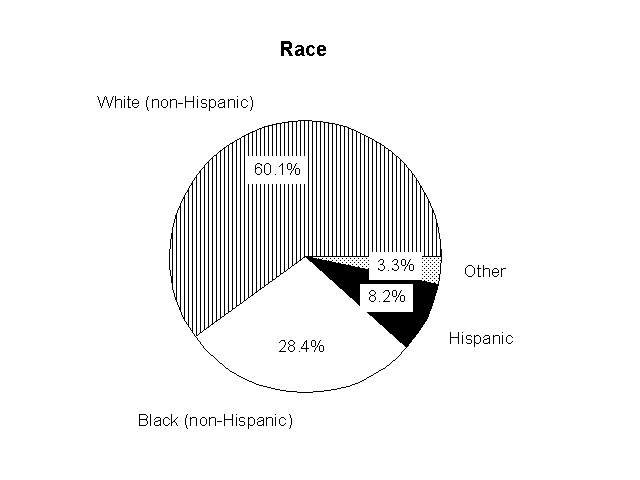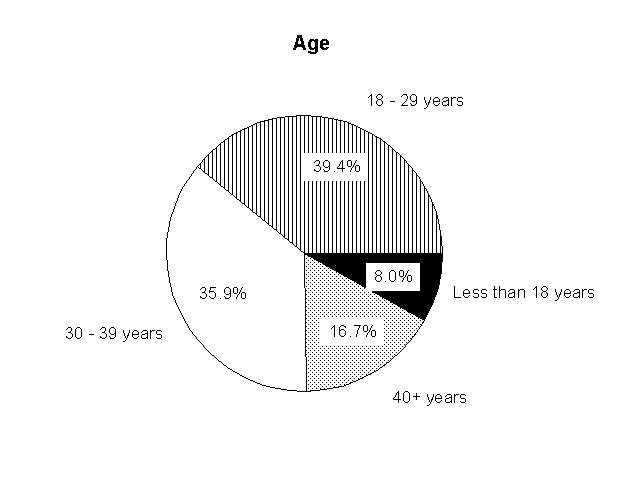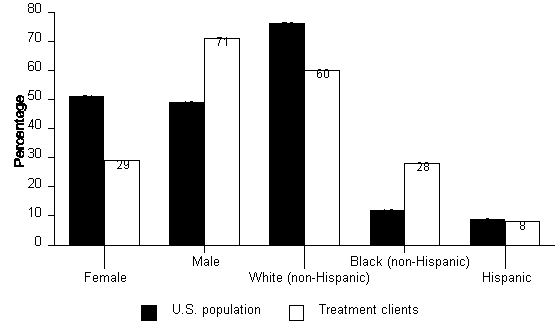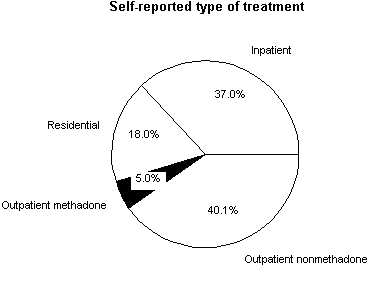| | |||||||||||
| |
| |||||||||||
|
Services Research Outcomes Study (SROS) | ||||||||||||
| | |||||||||||
| |
| |||||||||||
|
Services Research Outcomes Study (SROS) | ||||||||||||
CHARACTERISTICS OF CLIENTS BEFORE AND DURING TREATMENT
This section discusses the characteristics of clients using weighted data from the SROS client interviews—that is, estimating the characteristics of all clients discharged from each of the four types of treatment facilities during 1989–1990. The characteristics discussed here include those used recurrently to define subgroups throughout this chapter—that is, characteristics differentiating the client population by demographic categories, number of prior treatment episodes, main drug problem, length of stay, and reasons for seeking treatment—as well as characteristics for which repeated measures before and after treatment enable the estimation of changes associated with treatment episodes, such as changes in criminal activities and mental and physical health. (Treatment-associated changes are discussed in the subsequent section.)
Demographic Characteristics
Some variation existed in the characteristics of clients among the four facility types (see Table 3-3 and Figure 3-1). About 71 percent of clients were male and 29 percent were female, and this distribution did not vary much among types of treatment except for methadone facilities, in which the distribution was 55-percent male and 45-percent female. Gender distribution in methadone facilities thus was much closer to the 49-percent/51-percent gender distribution in the overall U.S. population in 1990 (see Figure 3-2). Although blacks compose 12 percent of the overall U.S. population, they are overrepresented in treatment facilities, composing one-third or more of patients discharged in all facility types except outpatient nonmethadone, in which 18 percent of the clients were black. The Hispanic subgroup closely approximated its overall percentage in the U.S. population (nine percent) but tended to be proportionately larger in outpatient facilities (12 percent) than in 24-hour facilities (five percent).
Three-fourths of all discharged treatment clients were 18 to 39 years old at the time of discharge in 1989–1990, whereas only one-third of the U.S. population was in the same age range (see Figure 3-2). Moreover, there were differences in the estimated age distributions by type of treatment. The outpatient nonmethadone group included a much higher proportion of adolescents (those under age 18) than the other types of treatment (14 percent versus four percent), so that more than two-thirds of all treated adolescents were discharged from outpatient nonmethadone treatment, composing just 40 percent of all discharges. In addition, one-half of all residential clients were ages 18 to 29 years, compared with less than 40 percent of all other discharged clients, and about one-half of all methadone clients were ages 30 to 39 years, compared with about one-third of all other discharged clients.
About 40 percent of clients had never married, 30 percent were formerly married, and 30 percent were currently married at the time of admission. Marital status did not vary greatly by type of treatment, except that fewer outpatient nonmethadone clients were in the ormerly married category. Finally, an estimated 18 percent of the client population had completed one to nine years of school. The remaining client population was about evenly divided among those who had completed ten or 11 years, 12 years exactly (including those with a GED), and 13 or more years (college level). There was little variation across treatment types in clients’ educational attainment or their self-reported reading ability.
Figure 3-1. Demographic characteristics of treatment clients

Figure 3-1. Demographic characteristics of treatment clients (continued)

Figure 3-2. Comparison of treatment clients and the U.S. population


Note: Data are from Table 3-3.
Prior Treatment Episodes
More than one-half (58 percent) of the clients discharged from treatment during 1989–1990 were in their first episode of treatment. Only 13 percent reported three or more prior treatment episodes (see Table 3-3 and Figure 3-3). Although the pattern of number of prior treatment episodes was similar in each treatment type, and the two 24-hour types were nearly identical on this dimension, the outpatient facilities diverged in opposite ways: About 66 percent of outpatient nonmethadone clients but only 45 percent of methadone clients were in their first episode, whereas only six percent of outpatient nonmethadone clients but 23 percent of methadone clients were in at least their third episode.
Main Drug Problem
Clients generally were using a "main drug" or combination of main drugs when they entered treatment; about one-half of the clients named more than one main drug. The distribution of main drugs among the four different types of treatment varied more dramatically than the distribution of client demographic characteristics among them. For example, according to the weighted survey responses (see Table 3-3), alcohol was the most common main drug leading to treatment across the four facility types, with almost two-thirds (64 percent) of all clients citing alcohol as a main drug. Overall, about one-quarter of the client population named marijuana (26 percent), cocaine (23 percent), and crack (22 percent) as main drugs, and about one-ninth (11 percent) of the clients were in treatment for heroin.
Methadone facilities were a notable exception to this general pattern. Less than one-third (31 percent) of clients in methadone facilities cited alcohol as a main drug. Heroin, on the other hand, was the main drug for 79 percent of methadone clients, in contrast to four percent of clients discharged from outpatient nonmethadone facilities, six percent from residential facilities, and 12 percent from inpatient [ In this section of the report, client data are classified and weighted according to the client ’s self-report of the type of the treatment received in the index episode, rather than the originating sample facility classifications inherited from DSRS. The SROS interview referred to "inpatient " rather than "hospital inpatient " treatment, and the interview terminology is followed here.] facilities. In other words, for the most part, methadone clinics treated clients whose main drug, heroin, was used by only a small proportion of clients treated in the other types of facilities. [ Although heroin is a proportionately atypical problem in treatment types other than methadone clinics, the converse is not true: Accessing other types of treatment is not unusual for heroin users. About two - thirds of the estimated number of clients whose main drug was heroin were discharged from facilities other than methadone clinics. Most of these heroin clients were in inpatient units, which discharged virtually the same estimated number of heroin clients in 1989 –1990 as methadone clinics did.]
Figure 3-3. Characteristics of treatment clients before and during treatment

Figure 3-3. Characteristics of treatment clients before and during treatment (contd.)


Methadone treatment was also exceptional in that a much smaller proportion of such clients reported marijuana or crack as a main drug, compared with all other facilities (ten-percent marijuana and eight-percent crack versus 27- and 23-percent, respectively). More generally, crack was treated much more often in 24-hour facilities than in the two outpatient types; 29 percent of inpatient and 39 percent of residential clients, compared with less than ten percent of methadone or outpatient nonmethadone clients, reported crack as a main drug.
The main drug at entry to treatment can also be separated into three mutually exclusive categories: alcohol only, alcohol and illicit drugs, and illicit drugs only. Each category defines about one-third of the overall client population (30, 35, and 36 percent, respectively). The profiles of inpatient and outpatient nonmethadone clients correspond with this roughly equal distribution across the three categories. Methadone treatment, as discussed above, is quite different, with 70 percent of its clients citing drugs only and five percent alcohol only. [ The SROS data suggest that some clients entering methadone treatment (which was designed for primary opiate addiction), but reporting only alcohol problems at admission, may have been chronic opiate addicts who had become dependent on alcohol in the course of trying to stave off a relapse to opiates, and found that using alcohol as a "blockade " was a failed strategy. In other words, clinicians may have used methadone as a prophylactic treatment for older, chronic opiate addicts to prevent an expected relapse to heroin or other narcotics. ] Also, a small proportion of residential clients (16 percent) listed their main drug as alcohol only, and nearly one-half (45 percent) of residential clients reported that their main drug was a combination of alcohol with one or more illicit drugs.
Type and Length of Stay in Treatment
The most common types of treatment episodes among all clients were inpatient and outpatient nonmethadone, with 37 percent and 40 percent of the population in each, respectively. Eighteen percent of the clients received residential treatment, and five percent were discharged from outpatient methadone treatment.
About 38 percent of clients remained in treatment from one to six months, and another 25 percent stayed between one week and one month. A smaller proportion of the population was in treatment for very long or short durations: About 18 percent stayed for six months or longer, and 19 percent stayed for less than one week. The highest proportion of very short stays (37 percent) and lowest proportion of very long stays (four percent) occurred in the facility type with the highest daily cost—inpatient facilities. The longest lengths of stay were in the outpatient nonmethadone and methadone facilities: 89 percent of those in outpatient nonmethadone treatment and 69 percent of those in methadone treatment stayed for at least one month.
Reasons for Going into Treatment
Clients went into treatment not only because they had problems controlling their drug use as such, but also to seek relief from problems either stemming directly from their drug useor occurring at the same time. These problems included pressure from the criminal justice system, poor health, pressure from or problems with family members, employer pressure, and financial trouble (see Table 3-4). These problems often came in multiples; although some clients cited none of them, most cited at least one, and one-half cited more than one. About one-half (48 percent) of the clients reported that they entered treatment because of family pressure, compared with 35 percent who reported they were pressured by the criminal justice system, 29 percent by financial problems, 25 percent by health problems, and eight percent by employers. The most salient variations across treatment types were that more than one-half (52 percent) of the clients in outpatient nonmethadone facilities cited pressure by the criminal justice system, and 39 percent of methadone clients cited financial problems.
Table 3-5 displays reasons for seeking treatment, with clients categorized by demographic information, main drug at intake, and length of stay. Males and females were quite similar in the percentages who cited health, family, and financial reasons for treatment, but males tended more often than females to cite pressure by criminal justice agents (38 versus 28 percent) and by employers (nine versus three percent). Among racial/ethnic groups, a much higher percentage of Hispanics than blacks cited pressure from the criminal justice system (56 percent versus 24 percent), with whites in between (37 percent); other reasons were cited at about the same rate across these racial/ethnic categories. Age was also correlated with reasons for treatment. Pressure from criminal justice sources decreased with increasing age (from 50 percent among adolescents to 25 percent among those 40 years and older), while health reasons increased with increasing age (from 11 percent among adolescents to 37 percent among those 40 and older). Financial problems were seldom cited by adolescents (six percent), but financial reasons for treatment rose to 36 percent among clients ages 30 to 39 years and diminished to 19 percent among those ages 40 and older.
With respect to main drug, and contrary to what one might anticipate, clients who cited marijuana and alcohol as main drugs were about twice as likely as those who cited cocaine, crack, or heroin to report criminal justice pressure as a reason for seeking treatment (46 and 39 percent versus 28, 21, and 25 percent [ Because clients could cite more than one main drug, there are overlaps among the populations being compared here.] ). Crack clients also tended to report family pressure more often than clients with other main drugs (63 percent versus 45 to 51 percent). Finally, there were clear associations between the length of stay in treatment and the reasons for going into treatment. For example, clients who stayed in treatment for more than one month were twice as likely to have had criminal justice pressure as clients who stayed for less than one month (45 percent versus 22 percent). In contrast, individuals with briefer lengths of stay were more likely to have health problems, family pressures, and financial problems.
In summary, the most common lines of association between client characteristics and reason for seeking treatment were with criminal justice pressure: Clients who were male, Hispanic, younger, cited marijuana or alcohol as main drugs, were in outpatient nonmethadone facilities, and stayed in treatment for longer periods were more likely to cite criminal justice pressure as a reason for treatment.
Criminal Behavior Before Treatment
Table 3-6 presents information on the prevalence of criminal behavior among clients before entering the index treatment episode in 1989–1990. Nearly 85 percent of the SROS population had been arrested at least once before entry into the index treatment episode, and the average age at first arrest was 21 years. In the five years immediately preceding the index treatment, only about one-quarter of the clients sampled were free of arrests, about one-third reported one or two arrests, and almost one-half reported three or more arrests. Little variation existed in arrest prevalence by type of treatment, but compared with other treatment types, residential clients tended to have more arrests (this group was also more likely to be male, use crack as a main drug, and be between the ages of 18 and 29), and outpatient nonmethadone clients had fewer arrests (this group was also more likely to be less than age 18, use only alcohol as a main drug, and be white).
More than one-quarter (27 percent) of clients supported themselves mainly by illegal activity for some period during the five years preceding treatment. However, 61 percent of the outpatient methadone clients, and only 17 percent of outpatient nonmethadone clients, reported this dependence on illegal activity for income, which is one of the most discriminating differences among clients in the four types of treatment. More than one-half of the SROS population (55 percent) had been incarcerated at least once in their lives, and most of these (44 percent of all clients) had been incarcerated during the five years prior to treatment, with the outpatient nonmethadone group marginally lower than the other treatment types in both respects (48 percent and 39 percent on the two measures, respectively).
Physical Health, Mental Health, and Physical Abuse
A substantial proportion of the client population was troubled by health problems (see Table 3-7). Only about one-quarter (24 percent) reported excellent health during the five years before the index treatment episode; about 43 percent reported good health, and one-third of the clients (33 percent) were in fair or poor health. The health status of outpatient nonmethadone clients was generally somewhat better than other clients, and the health of clients in inpatient facilities was, not surprisingly, generally worse. The most common lifetime health problems among the client population were serious internal conditions such as ulcers, diabetes, kidney problems, or liver problems other than hepatitis (26 percent); breathing conditions other than tuberculosis (22 percent); and heart or blood problems, including high blood pressure (21 percent). A history of hepatitis or yellow jaundice was markedly prevalent among the (mostly drug-injecting) methadone clients (35 percent), and tuberculosis was highly prevalent among residential clients (20 percent).
The mental health history of clients was also highly troubled, often (but not always) as a result of drug or alcohol use (see Table 3-8). In the five years before the index treatment episode, more than one-half of the client population (54 percent) experienced a period of sadness or depression that lasted more than two weeks. Although no strictly comparable (five-year prevalence) data exist on the general population, this level is several multiples above what one would expect (Kessler et al., 1994; Substance Abuse and Mental Health Services Administration, 1996). About two-thirds of those reporting depression (36 percent of all clients) stated that their unhappiness was at times the result of alcohol or drug use. One-quarter of the client population had attempted suicide at some time in their lives. About 15 percent reported that they attempted suicide at least once during the five years before treatment, and about two-thirds of these (ten percent of the client population) reported that these attempts were a result of alcohol or drug use. One-half (48 percent) of all clients reported trouble controlling their temper, and about two-thirds (33 percent of the total population) of those who reported trouble controlling their temper indicated this was the result of alcohol or drug use. More than one-quarter (28 percent) of all clients had hallucinations or delusions in their lifetimes, and two-thirds of this group (19 percent of the total SROS population) had this problem during the five years prior to treatment.
Finally, physical abuse is relatively common in the lives of the client population (see Table 3-8). In the five years before treatment, one-third of clients (32 percent) had been attacked with a weapon, such as a knife or gun, or been seriously hit or beaten. About one-fifth had been badly bruised, visited a doctor, or stayed in bed for one day or more as a result of the attack.
|
|
 |
Click to Return to OAS Home Page |
This page was last updated on April 29, 2004 .
|
|